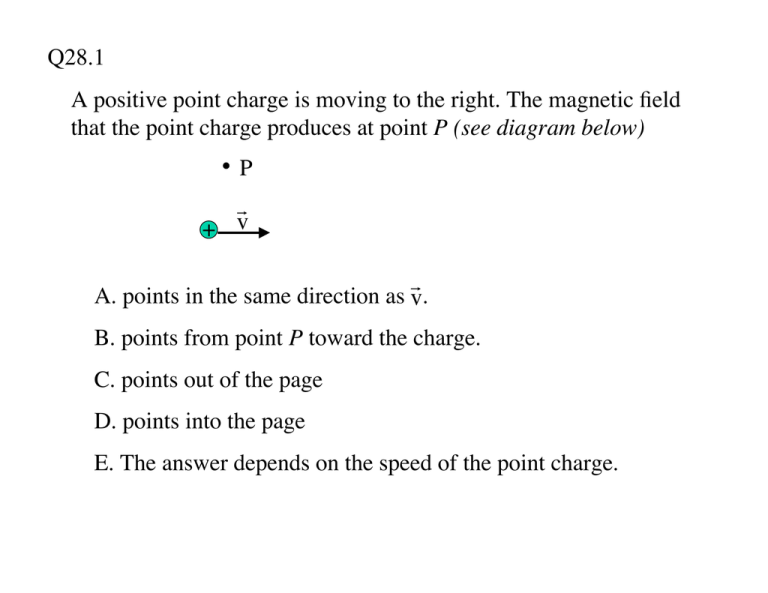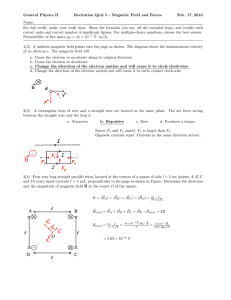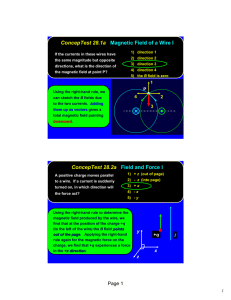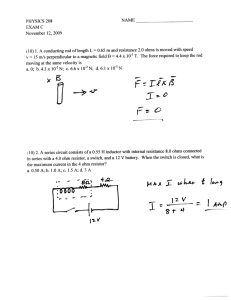iclicker#8
advertisement

Q28.1 A positive point charge is moving to the right. The magnetic field that the point charge produces at point P (see diagram below) P r + v r A. points in the same direction as v. B. points from point P toward the charge. C. points out of the page D. points into the page E. The answer depends on the speed of the point charge. A28.1 A positive point charge is moving to the right. The magnetic field that the point charge produces at point P (see diagram below) P r + v r A. points in the same direction as v. B. points from point P toward the charge. C. points out of the page D. points into the page E. The answer depends on the speed of the point charge. Q28.2 A positive point charge is moving directly toward point P. The magnetic field that the point charge produces at point P r + v P A. points from the charge toward point P. B. points from point P toward the charge. C. points out of the page D. points into the page E. is zero. A28.1 A positive point charge is moving directly toward point P. The magnetic field that the point charge produces at point P r + v P A. points from the charge toward point P. B. points from point P toward the charge. C. points out of the page D. points into the page E. is zero. Q28.3 +q r v +q r v Two positive point charges move side by side in the same direction with the same velocity. What is the direction of the magnetic force that the upper point charge exerts on the lower one? A. toward the upper point charge (the force is attractive) B. away from the upper point charge (the force is repulsive) C. in the direction of the velocity D. opposite to the direction of the velocity E. none of the above A28.3 +q r v +q r v Two positive point charges move side by side in the same direction with the same velocity. What is the direction of the magnetic force that the upper point charge exerts on the lower one? A. toward the upper point charge (the force is attractive) B. away from the upper point charge (the force is repulsive) C. in the direction of the velocity D. opposite to the direction of the velocity E. none of the above Q28.4 A long straight wire lies along the y–axis and carries current in the positive y–direction. A positive point charge moves along the x–axis in the positive x–direction. The magnetic force that the wire exerts on the point charge is in A. the positive x–direction. y r v O +q B. the negative x–direction. C. the positive y–direction. D. the negative y–direction. E. none of the above I x A28.4 A long straight wire lies along the y–axis and carries current in the positive y–direction. A positive point charge moves along the x–axis in the positive x–direction. The magnetic force that the wire exerts on the point charge is in A. the positive x–direction. y r v O +q B. the negative x–direction. C. the positive y–direction. D. the negative y–direction. E. none of the above I x Q28.5 Two long, straight wires are oriented perpendicular to the xy–plane. They carry currents of equal magnitude I in opposite directions as shown. At point P, the magnetic field due to these currents is in A. the positive x–direction. B. the negative x–direction. C. the positive y–direction. D. the negative y–direction. E. none of the above A28.5 Two long, straight wires are oriented perpendicular to the xy–plane. They carry currents of equal magnitude I in opposite directions as shown. At point P, the magnetic field due to these currents is in A. the positive x–direction. B. the negative x–direction. C. the positive y–direction. D. the negative y–direction. E. none of the above Q28.6 The long, straight wire AB carries a 14.0-A current as shown. The rectangular loop has long edges parallel to AB and carries a clockwise 5.00-A current. What is the direction of the net magnetic force that the straight wire AB exerts on the loop? A. to the right B. to the left C. upward (toward AB) D. downward (away from AB) E. misleading question — the net magnetic force is zero A28.6 The long, straight wire AB carries a 14.0-A current as shown. The rectangular loop has long edges parallel to AB and carries a clockwise 5.00-A current. What is the direction of the net magnetic force that the straight wire AB exerts on the loop? A. to the right B. to the left C. upward (toward AB) D. downward (away from AB) E. misleading question — the net magnetic force is zero Q28.7 A wire consists of two straight sections with a semicircular section between them. If current flows in the wire as shown, what is the direction of the magnetic field at P due to the current? A. to the right B. to the left C. out of the plane of the figure D. into the plane of the figure E. misleading question — the magnetic field at P is zero A28.7 A wire consists of two straight sections with a semicircular section between them. If current flows in the wire as shown, what is the direction of the magnetic field at P due to the current? A. to the right B. to the left C. out of the plane of the figure D. into the plane of the figure E. misleading question — the magnetic field at P is zero Q28.8 The wire shown here is infinitely long and has a 90° bend. If current flows in the wire as shown, what is the direction of the magnetic field at P due to the current? A. to the right B. to the left C. out of the plane of the figure D. into the plane of the figure E. none of these A28.8 The wire shown here is infinitely long and has a 90° bend. If current flows in the wire as shown, what is the direction of the magnetic field at P due to the current? A. to the right B. to the left C. out of the plane of the figure D. into the plane of the figure E. none of these Q28.9 The figure shows, in cross section, three conductors that carry currents perpendicular to the plane of the figure. If the currents I1, I2, and I3 all have the same magnitude, for which path(s) is the line integral of the magnetic field equal to zero? A. path a only B. paths a and c C. paths b and d D. paths a, b, c, and d E. The answer depends on whether the integral goes clockwise or counterclockwise around the path. A28.9 The figure shows, in cross section, three conductors that carry currents perpendicular to the plane of the figure. If the currents I1, I2, and I3 all have the same magnitude, for which path(s) is the line integral of the magnetic field equal to zero? A. path a only B. paths a and c C. paths b and d D. paths a, b, c, and d E. The answer depends on whether the integral goes clockwise or counterclockwise around the path. Q28.10 The figure shows, in cross section, two conductors that carry currents perpendicular to the plane of the figure. Both current have the same magnitude. Amperian loop Which of the following statement is NOT true? A. The line integral of the magnetic field along the Amperian loop is zero B. The magnetic field is zero along the Amperian loop. C. The Amperian loop enclosed a net zero current. D. The dot product B and dl is positive for part of the loop and negative for part of the loop. r dl A28.10 The figure shows, in cross section, two conductors that carry currents perpendicular to the plane of the figure. Both current have the same magnitude. Amperian loop Which of the following statement is NOT true? A. The line integral of the magnetic field along the Amperian loop is zero B. The magnetic field is zero along the Amperian loop. C. The Amperian loop enclosed a net zero current. D. The dot product B and dl is positive for part of the loop and negative for part of the loop. r dl




